What Is A V5C?
The V5C document (formerly V5), commonly known as a vehicle’s log book, is the registration certificate for UK vehicles. This document is used by the DVLA to keep track of any changes during a vehicle’s lifetime (such as a new owner or address).
When any vehicle is first manufactured and sold on to the market, the DVLA retain records detailing the manufacturer, colour and the vehicle engine size. Whenever a vehicle is bought or sold, repaired, modified or imported, the V5C needs to be updated and sent back to the DVLA. This legal requirement ensures that the DVLA’s records for UK vehicles are up to date, including a particular person named as liable for each car on the road.

Why Do You Need A V5C Document?
All new UK vehicles are issued with a V5C document and it’s extremely important that this document remains up to date. Failure to keep your V5C logbook up to date may result in a fine by the DVLA, and you could also find yourself liable for a new owner’s parking tickets, speeding fines etc if you don’t advise the DVLA that the car you’ve sold has a new registered keeper.
Whenever a vehicle is sold both the owner and the purchaser need to complete relevant sections of the V5C document to ensure that DVLA records are updated, and that transfer of ownership is properly verified.
Another reason you need a V5C logbook document is for taxing your car or vehicle. You can use a vehicle tax reminder (V11) sent to you by the DVLA for taxing your vehicle, however, when you tax it for the first time you will need to refer to reference numbers on your V5C.
What To Complete On The V5C When Selling Your Vehicle For Salvage
Rest assured the collectors on the Scrap Car Comparison network have many years of experience collecting vehicles and will always be willing to help you if you have anything which you are unsure of when selling a vehicle for salvage.
In any case, completing the V5C paperwork when you sell your vehicle for salvage is not as complex as you might think. Simply fill out section 4 of the form (on earlier versions of the V5C, section 9 is the one to complete). The purchaser will also need to complete this section of the form. Once complete and signed by both parties, you should post this section to the DVLA at DVLA, Swansea, SA99 1AR.
What To Complete On The V5C When Selling Your Vehicle For Scrap
When selling vehicles for scrap the paperwork process is the same as selling for salvage: the buyer and seller should complete section 4 (section 9 on old V5Cs) and the seller should send the completed section 4 form to the DVLA to be processed.
When vehicles are sold for scrap the collection agent will sign on behalf of their Authorised Treatment Facility (ATF). Once the vehicle has been dismantled for recycling a Certificate of Destruction (COD) is issued for the scrapped car. This document is received by the final owner of the car before it was depolluted, dismantled and recycled. Following the dismantling of a scrapped car the ATF must legally issue a corresponding COD to notify relevant the person that a vehicle has been destroyed. CODs take approximately 7 days to be received by the final owner of the vehicle (despite some popular misconceptions, previous owners are not notified). Only the very last owner receives the COD, so there is no reason to panic if you have scrapped your car but not received one – technically, the collector of the car were the last registered owner, so it is the collector who typically receives the COD.
Guide To Completing Your V5C Document
Facing official paperwork you are not familiar with can be stressful – what sections do you need to fill out? Which do you leave blank? So we’ve broken down each section of the V5C document to help you understand it and complete it with confidence.
IMPORTANT NOTE: This information is based on the most recent version of the V5C, which began to be issued by the DVLA in April 2019. If you have a V5C issued before this date (NB your V5C has more than 6 number sections), please refer to our guide to the previous V5C document.
V5C Multi-Colour Guidance Panel
On the front cover of your V5C, you’ll see a panel giving guidance about the six sections:
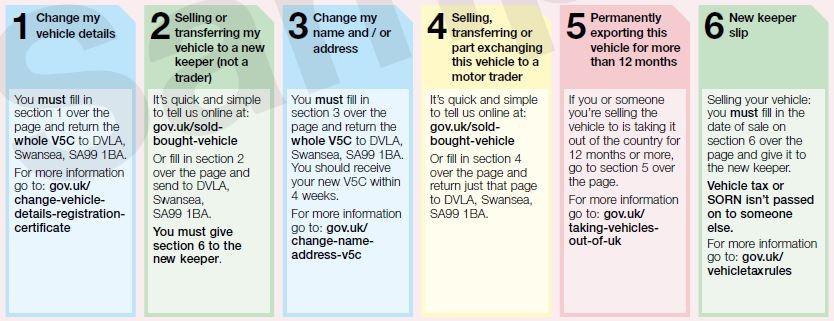
Don’t see it? You probably have an older version of the V5C form. Don’t worry – we have guidance on this version of the form that you can review here.
The V5C Vehicle Details Section
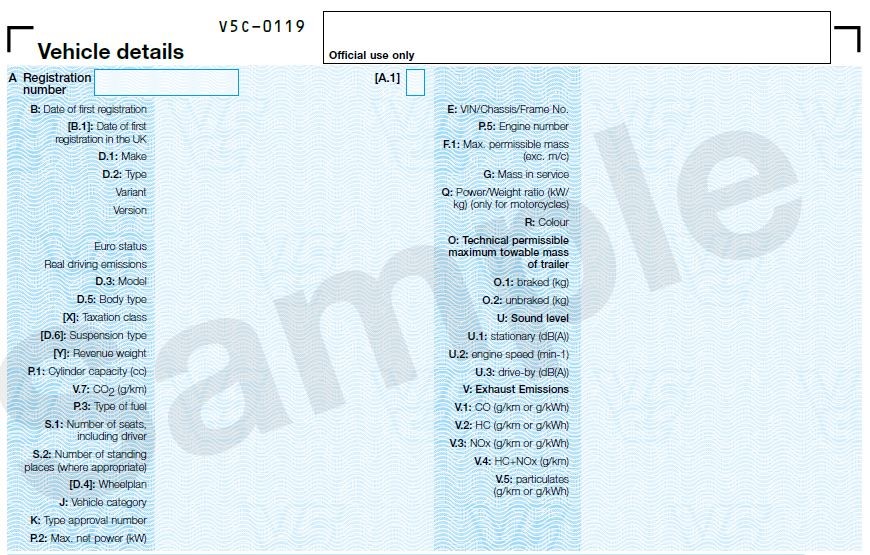
This section is on the top left when you open up your V5C document. The illustration shows a blank sample – your V5C will already have printed on it all the details about your vehicle which the DVLA need to keep record of. It’s also a useful guide for you about your vehicle if you need to get a quote for insurance.
The Vehicle Details section of the V5C log book is for reference purposes – you won’t ever need to write anything in this section.
Section One of Your V5C: Change my vehicle details

Have you made any changes to your vehicle? If so, you need to tell the DVLA using section one of your V5C. If you are wondering what counts as a change, it could be any of the following:
- The car’s colour
- The car engine
- The car engine’s cylinder capacity (cc)
- The fuel type you use for your car
- Your car’s chassis or bodyshell (replaced or modified)
- The vehicle seating capacity
- The weight of a large vehicle, for example goods vehicle or campervan
- The tax class of your vehicle
You’ll see on the section where you can enter the new information that the DVLA need; once complete, post the whole V5C document to the DVLA address shown in the top right of this section.
If your vehicle has had no changes made, you can feel free disregard section one of the V5C.
Section Two of Your V5C: Selling or transferring my vehicle to a new keeper (not a trader)
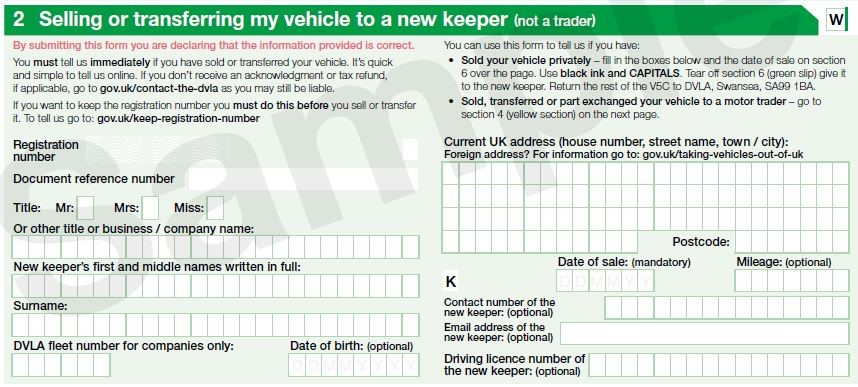
If you’ve sold your car or vehicle privately, you should complete this section of the V5C with the details of the person you are selling it to and return it to the DVLA.
If you’re selling your car to a trader, or a scrap or salvage company, you should use section four of your V5C instead.
If you’re not privately selling your vehicle, you can disregard section two of the V5C.
Section Three of Your V5C: Change my name and/or address
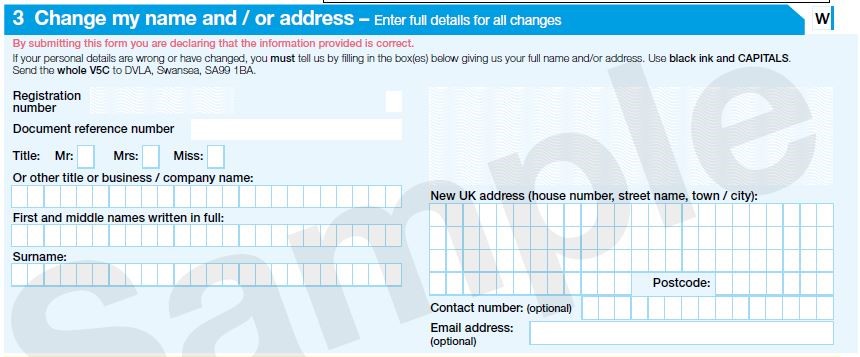
Changed your name or address? It’s important you complete section three of the V5C with your new personal details, and send the whole V5C back to the DVLA, posting it to the address shown near the top of this section.
Section Four of Your V5C: Selling, transferring or part exchanging this vehicle to a motor trader
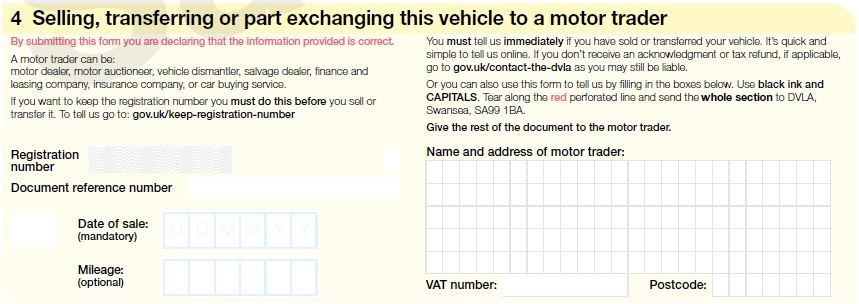
Seeing the words “part exchanging” and “motor trader” might make you think section four of the V5C is only for when you part-exchange your old car for a new one. However, it should also be used when selling your car for scrap or salvage, donating your car to charity via a scrap or salvage company – basically any situation where the car doesn’t go to a new private keeper, but a commercial company.
Section Five of Your V5C: Permanently exporting this vehicle for more than 12 months

If you are planning to export your vehicle to another country for over 12 months, you need to complete section 5 of your V5C with the date of export and the country you are exporting your vehicle to.
If you are not exporting your vehicle, you can disregard section five of your V5C.
Section Six of Your V5C: New keeper slip – must be given to the new keeper
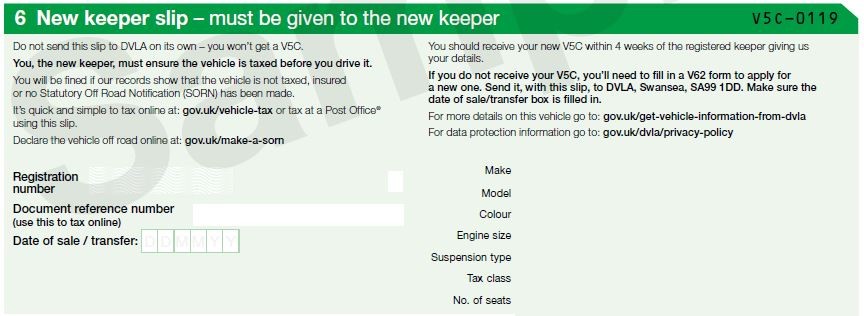
When you sell your car or vehicle, section 6 of your V5C should be passed to the new owner. Our illustration above shows a blank sample form – in practice, V5Cs will have this section printed with the details of the specific car or vehicle which the V5C relates to.
How To Replace A Lost Or Missing V5C Log Book Document
If you’ve lost a V5C, it’s straightforward to apply for a replacement from the DVLA for a £25 fee. If you are already the vehicle’s registered keeper and none of the details of you or your vehicle have changed, you can request the new V5C by phoning the DVLA; they’ll take the £25 charge over the phone by credit or debit card.
If you’ve bought a car and the previous keeper has not notified the DVLA, this would cause a problem with you receiving a V5C in your name for your new car. If this happens, you can complete a V62 form and send it to the DVLA along with the green “new keeper” slip the previous owner provided you with. Bear in mind that you should wait four weeks after buying the car before taking this step, just in case your V5C has been delayed at the DVLA or in the postal system.
The contact details for calling or sending your forms to the DVLA are as follows:
DVLA Contact Details:
Phone: 0300 790 6802
Address: DVLA, Swansea, SA99 1AR.



